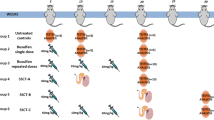Abstract
This study describes the morphological behaviour of spermatogonia following recovery from two doses of busulfan treatment in the rat. Twenty days after the second intraperitoneal injection of busulfan, the testes lost most of their spermatogenic cells and there were fewer dispersed singly surviving spermatogonia. These surviving cells were in close contact with the basal portions of adjacent Sertoli cells and the shrunken basal lamina, and were the source for repopulating the depleted seminiferous epithelium. During the initial stage of repopulation (48 days later), surviving spermatogonia underwent a phase of active proliferation: type A spermatogonia underwent symmetric and asymmetric divisions; type B spermatogonia underwent asynchronous differentiation. At day 96, normal spermatogenesis was fully recovered in many seminiferous tubules, represented by 80% of the rats regaining various degrees of fertility at day 120. These data provide an additional model for the study of self-renewal of stem spermatogonia and suggest that the asymmetric division of type A spermatogonia and their close contact with both the basal lamina and the Sertoli cells may be involved in regulating the number of stem spermatogonia and the delicate process of normal spermatogenesis.
Similar content being viewed by others
Author information
Authors and Affiliations
Additional information
Accepted: 17 March 1998
Rights and permissions
About this article
Cite this article
Jiang, FX. Behaviour of spermatogonia following recovery from busulfan treatment in the rat. Anat Embryol 198, 53–61 (1998). https://doi.org/10.1007/s004290050164
Issue Date:
DOI: https://doi.org/10.1007/s004290050164



